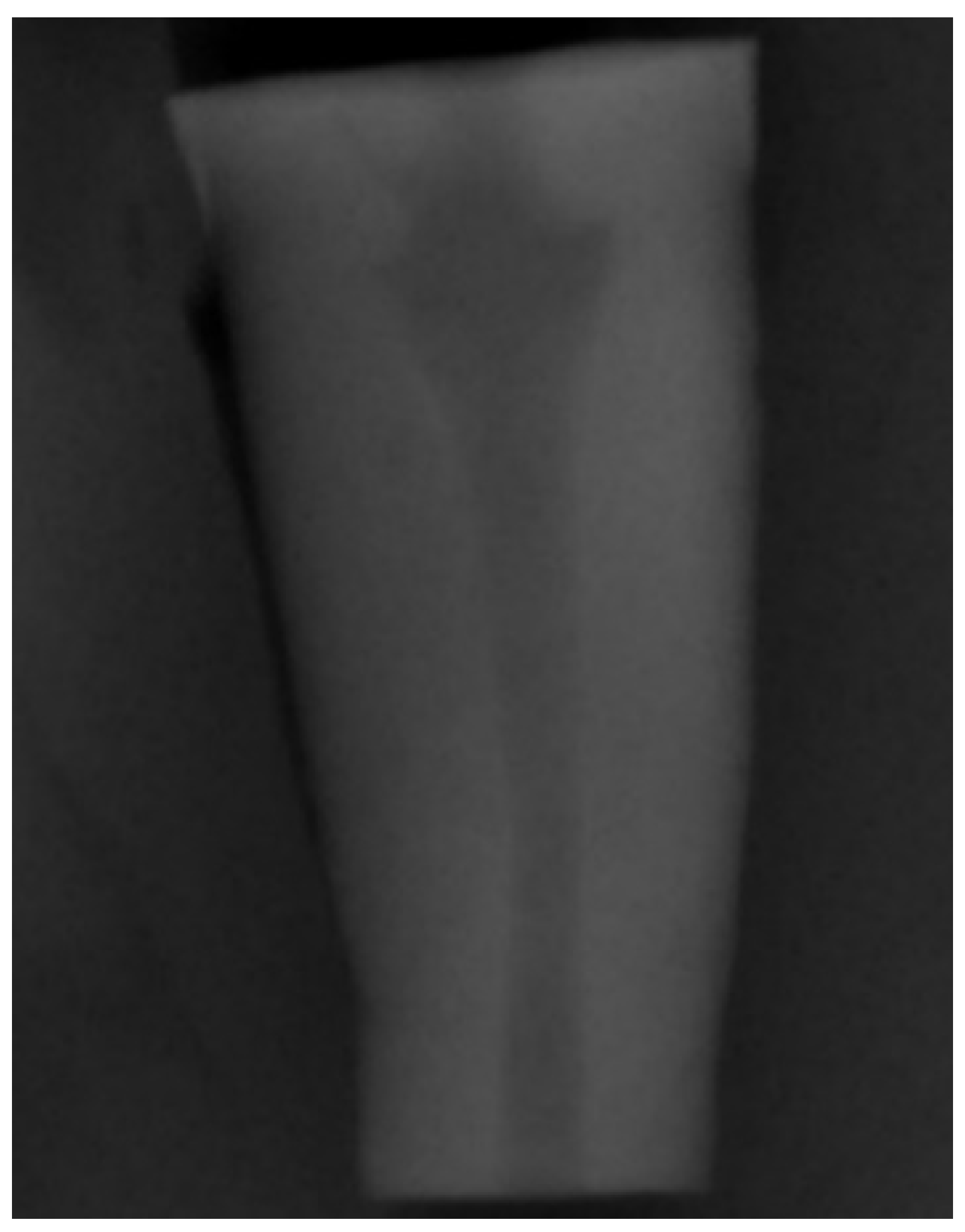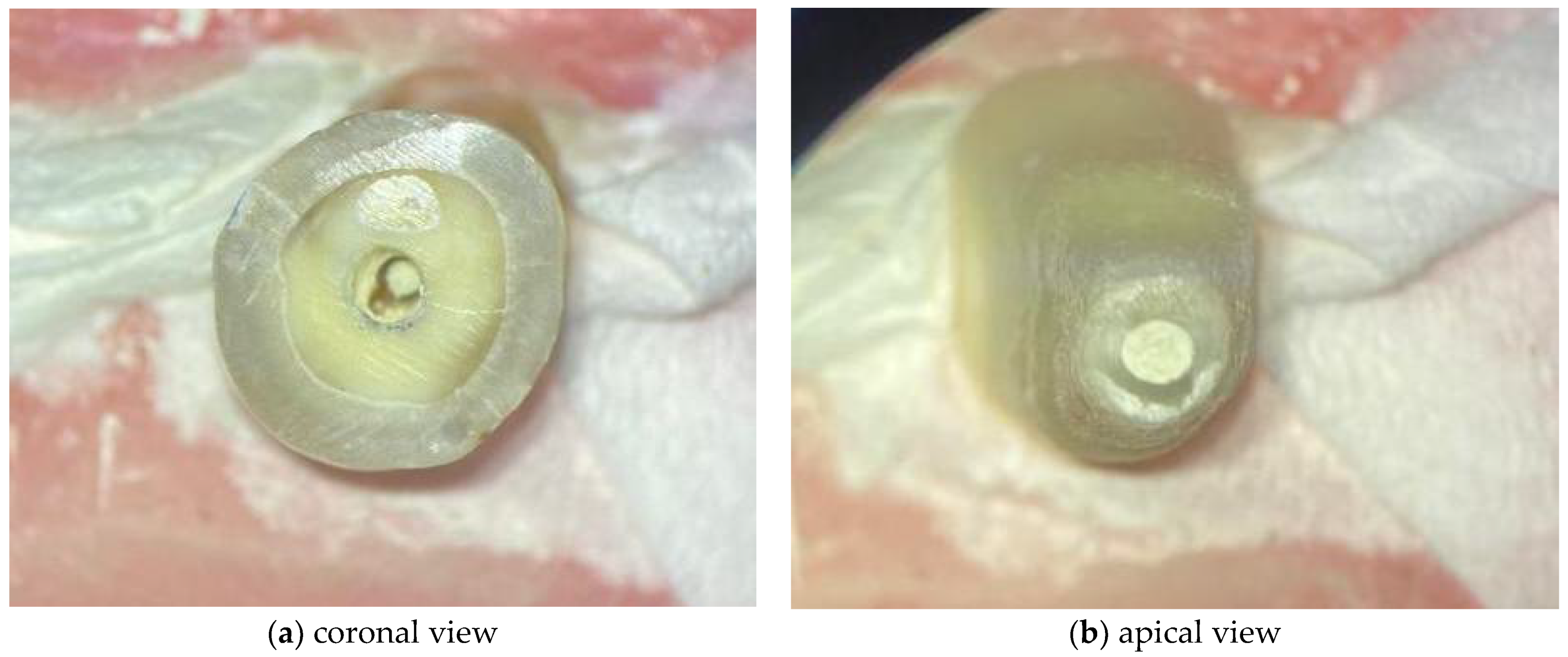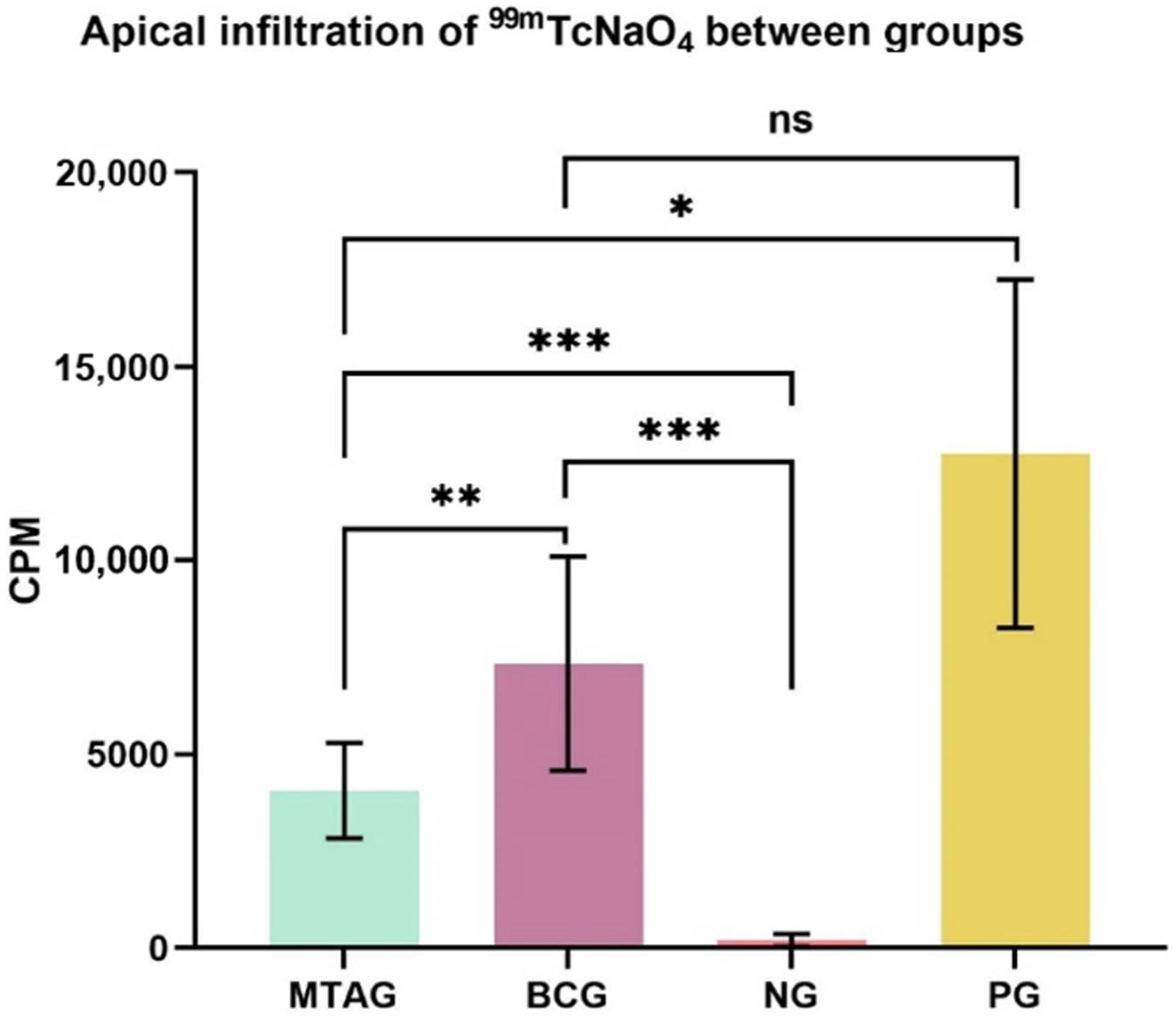Apical Sealing Ability of Two Calcium Silicate-Based Sealers Using a Radioactive Isotope Method: An In Vitro Apexification Model
Abstract
1. Introduction
2. Materials and Methods
2.1. Collection of the Sample
2.2. Preparation
2.3. Groups
- ProRoot White MTA group (MTAG, n = 12);
- TotalFill BC RRM Fast Set Putty group (BCG, n = 12).
- Negative control group (NG, n = 5);
- Positive control group (PG, n = 5).
2.4. Endodontic Sealers
2.5. Obturation
2.6. Infiltration
2.7. Statistical Analysis
3. Results
4. Discussion
5. Conclusions
Author Contributions
Funding
Institutional Review Board Statement
Informed Consent Statement
Data Availability Statement
Acknowledgments
Conflicts of Interest
References
- Moore, A.; Howley, M.F.; O’Connell, A.C. Treatment of open apex teeth using two types of white mineral trioxide aggregate after initial dressing with calcium hydroxide in children. Dent Traumatol. 2011, 27, 166–173. [Google Scholar] [CrossRef] [PubMed]
- Nicoloso, G.F.; Pötter, I.G.; Rocha, R.; de Montagner, O.F.; Casagrande, L. A comparative evaluation of endodontic treatments for immature necrotic permanent teeth based on clinical and radiographic outcomes: A systematic review and meta-analysis. Int. J. Paediatr. Dent. 2017, 27, 217–227. [Google Scholar] [CrossRef] [PubMed]
- Waterhouse, P.; Whitworth, J.; Camp, J.; Fuks, A. Pediatric endodontics: Endodontic treatment for the primary and young permanent dentition. In Hargreaves KM, Cohen S Cohen’s Pathways of the Pulp, 10th ed.; Mosby Elsevier: Saint-Louis, MI, USA, 2011. [Google Scholar]
- Hachmeister, D.R.; Schindler, W.G.; Walker, W.A.; Thomas, D.D. The sealing ability and retention characteristics of mineral trioxide aggregate in a model of apexification. J. Endod. 2002, 28, 386–390. [Google Scholar] [CrossRef] [PubMed]
- Lertmalapong, P.; Jantarat, J.; Srisatjaluk, R.L.; Komoltri, C. Bacterial leakage and marginal adaptation of various bioceramics as apical plug in open apex model. J. Investig. Clin. Dent. 2019, 10, e12371. [Google Scholar] [CrossRef]
- Ørstavik, D.; Qvist, V.; Stoltze, K. A multivariate analysis of the outcome of endodontic treatment. Eur. J. Oral Sci. 2004, 112, 224–230. [Google Scholar] [CrossRef] [PubMed]
- Trope, M. Treatment of the Immature Tooth with a Non-Vital Pulp and Apical Periodontitis. Dent. Clin. N. Am. 2010, 54, 313–324. [Google Scholar] [CrossRef]
- Hargreaves, K.M.; Diogenes, A.; Teixeira, F.B. Treatment options: Biological basis of regenerative endodontic procedures. J. Endod. 2013, 39, S30–S43. [Google Scholar] [CrossRef]
- Agrafioti, A.; Giannakoulas, D.G.; Filippatos, C.G.; Kontakiotis, E.G. Analysis of clinical studies related to apexification techniques. Eur. J. Paediatr. Dent. 2017, 18, 273–284. [Google Scholar]
- Ayatollahi, F.; Zarebidoki, F.; Razavi, S.H.; Tabrizizadeh, M.; Ayatollahi, R.; Heydarigujani, M. Comparison of Microleakage of CEM Cement Apical Plug in Different Powder/Liquid Ratio in Immature Teeth Using Fluid Filtration Technique. J. Dent. 2019, 20, 37–41. [Google Scholar]
- Morse, D.R.; O’Larnic, J.; Yesilsoy, C. Apexification: Review of the literature. Quintessence Int. 1990, 21, 589–598. [Google Scholar] [PubMed]
- Mackie, I.C. UK National Clinical Guidelines in Paediatric Dentistry. Management and root canal treatment of non-vital immature permanent incisor teeth. Faculty of Dental Surgery, Royal College of Surgeons. Int. J. Paediatr. Dent. 1998, 8, 289–293. [Google Scholar]
- Masmoudi, F.; Bourmeche, I.; Sebai, A.; Baccouche, Z.; Maatouk, F. Root lengthening with apical closure in two maxillary immature permanent central incisors after placement of mineral trioxide aggregate (MTA) as an apical plug. Eur. Arch. Paediatr. Dent. 2018, 19, 65–71. [Google Scholar] [CrossRef]
- Lim, M.; Jung, C.; Shin, D.-H.; Cho, Y.-B.; Song, M. Calcium silicate-based root canal sealers: A literature review. Restor. Dent. Endod. 2020, 45, e35. [Google Scholar] [CrossRef] [PubMed]
- Matt, G.D.; Thorpe, J.R.; Strother, J.M.; McClanahan, S.B. Comparative study of white and gray Mineral Trioxide Aggregate (MTA) simulating a one- or two-step apical barrier technique. J. Endod. 2004, 30, 876–879. [Google Scholar] [CrossRef]
- Roberts, H.W.; Toth, J.M.; Berzins, D.W.; Charlton, D.G. Mineral trioxide aggregate material use in endodontic treatment: A review of the literature. Dent. Mater. 2008, 24, 149–164. [Google Scholar] [CrossRef] [PubMed]
- Parirokh, M.; Torabinejad, M. Mineral Trioxide Aggregate: A Comprehensive Literature Review-Part III: Clinical Applications, Drawbacks, and Mechanism of Action. J. Endod. 2010, 36, 400–413. [Google Scholar] [CrossRef]
- Gartner, A.H.; Dorn, S.O. Advances in endodontic surgery. Dent. Clin. N. Am. 1992, 36, 357–378. [Google Scholar]
- Kadić, S.; Baraba, A.; Miletić, I.; Ionescu, A.; Brambilla, E.; Malčić, A.I.; Gabrić, D. Push-out bond strength of three different calcium silicate-based root-end filling materials after ultrasonic retrograde cavity preparation. Clin. Oral Investig. 2017, 22, 1559–1565. [Google Scholar] [CrossRef] [PubMed]
- Al-Haddad, A.; Aziz, Z.A.C.A. Bioceramic-Based Root Canal Sealers: A Review. Int. J. Biomater. 2016, 2016, 9753210. [Google Scholar] [CrossRef]
- Martinho, J.P.; França, S.; Paulo, S.; Paula, A.B.; Coelho, A.S.; Abrantes, A.M.; Caramelo, F.; Carrilho, E.; Marto, C.M.; Botelho, M.F.; et al. Effect of Different Irrigation Solutions on the Diffusion of MTA Cement into the Root Canal Dentin. Materials 2020, 13, 5472. [Google Scholar] [CrossRef] [PubMed]
- Fonseca, D.A.; Paula, A.B.; Marto, C.M.; Coelho, A.; Paulo, S.; Martinho, J.P.; Carrilho, E.; Ferreira, M.M. Biocompatibility of Root Canal Sealers: A Systematic Review of In Vitro and In Vivo Studies. Materials 2019, 12, 4113. [Google Scholar] [CrossRef]
- Wang, Z. Bioceramic materials in endodontics. Endod. Top. 2015, 32, 3–30. [Google Scholar] [CrossRef]
- Tran, D.; He, J.; Glickman, G.N.; Woodmansey, K.F. Comparative Analysis of Calcium Silicate–based Root Filling Materials Using an Open Apex Model. J. Endod. 2016, 42, 654–658. [Google Scholar] [CrossRef] [PubMed]
- Parirokh, M.; Torabinejad, M. Mineral Trioxide Aggregate: A Comprehensive Literature Review-Part I: Chemical, Physical, and Antibacterial Properties. J. Endod. 2010, 36, 16–27. [Google Scholar] [CrossRef]
- Nair, U.; Ghattas, S.; Saber, M.; Natera, M.; Walker, C.; Pileggi, R. A comparative evaluation of the sealing ability of 2 root-end filling materials: An in vitro leakage study using Enterococcus faecalis. Oral Surg. Oral Med. Oral Pathol. Oral Radiol. Endodontol. 2011, 112, e74–e77. [Google Scholar] [CrossRef] [PubMed]
- Antunes, H.S.; Gominho, L.F.; Andrade-Junior, C.V.; Dessaune-Neto, N.; Alves, F.R.F.; Rôças, I.N.; Siqueira, J.F. Sealing ability of two root-end filling materials in a bacterial nutrient leakage model. Int. Endod. J. 2015, 49, 960–965. [Google Scholar] [CrossRef]
- Caronna, V.; Himel, V.; Yu, Q.; Zhang, J.-F.; Sabey, K. Comparison of the Surface Hardness among 3 Materials Used in an Experimental Apexification Model under Moist and Dry Environments. J. Endod. 2014, 40, 986–989. [Google Scholar] [CrossRef]
- Memiş Özgül, B.; Bezgin., T.; Şahin, C.; Sari, Ş. Resistance to leakage of various thicknesses of apical plugs of Bioaggregate using liquid filtration model. Dent Traumatol. 2015, 31, 250–254. [Google Scholar] [CrossRef] [PubMed]
- Sarris, S.; Tahmassebi, J.F.; Duggal, M.S.; Cross, I.A. A clinical evaluation of mineral trioxide aggregate for root-end closure of non-vital immature permanent incisors in children-a pilot study. Dent Traumatol. 2008, 24, 79–85. [Google Scholar] [CrossRef]
- Lagisetti, A.K.; Hegde, P.; Hegde, M.N. Evaluation of bioceramics and zirconia-reinforced glass ionomer cement in repair of furcation perforations: An in vitro study. J. Conserv. Dent. 2018, 21, 184–189. [Google Scholar] [CrossRef]
- Alsubait, S.; Al-Haidar, S.; Al-Sharyan, N. A Comparison of the Discoloration Potential for EndoSequence Bioceramic Root Repair Material Fast Set Putty and ProRoot MTA in Human Teeth: An In Vitro Study. J. Esthet. Restor. Dent. 2016, 29, 59–67. [Google Scholar] [CrossRef] [PubMed]
- Siqueira, J.F.J. Aetiology of root canal treatment failure: Why well-treated teeth can fail. Int. Endod. J. 2001, 34, 1–10. [Google Scholar] [CrossRef] [PubMed]
- Mazzi, U. Technetium-99m Pharmaceuticals: Preparation and Quality Control in Nuclear Medicine, 1st ed.; Zolle, I., Ed.; Springer: Berlin, Germany, 2007; p. 95. [Google Scholar]
- Gogna, R.; Jagadis, S.; Shashikal, K. A comparative in vitro study of microleakage by a radioactive isotope and compressive strength of three nanofilled composite resin restorations. J. Conserv. Dent. 2011, 14, 128–131. [Google Scholar] [CrossRef]
- Jafari, F.; Rahimi, S.; Shahi, S.; Jafari, S. Endodontic microleakage studies: Correlation among different methods, clinical relevance, and potential laboratory errors. Minerva Stomatol. 2017, 66, 169–177. [Google Scholar] [PubMed]
- Camps, J.; Pashley, D. Reliability of the Dye Penetration Studies. J. Endod. 2003, 29, 592–594. [Google Scholar] [CrossRef]
- Afonso, T.; Pega, M.L.S.; de Michelotto, A.L.; Abrantes, A.M.C.; Oliveiros, B.; Carrilho, E.V.P. Effect of calcium hydroxide as intracanal medication on the apical sealing ability of mineral trioxide aggregate (MTA): An in vitro apexification model TT —Efeito da medicação intracanal de hidróxido de cálcio na capacidade seladora do mineral trióxido. J. Health Sci. Inst. 2012, 30, 104–112. [Google Scholar] [CrossRef]
- Ferreira, M.M.; Abrantes, M.; Carrilho, E.V.; Botelho, M.F. Quantitative scintigraphic analysis of the apical seal in Thermafil/Topseal and RealSeal 1/Realseal filled root canals. World J. Stomatol. 2013, 2, 30. [Google Scholar] [CrossRef]
- Keshava Prasad, B.; Sudhakaran, S. Radioactive Isotope Evaluation of Coronal Leakage after Endodontic Treatment in Teeth Restored with Three Different In-tracoronal Restorative Materials: An in vitro Study. World J. Dent. 2011, 2, 35–38. [Google Scholar] [CrossRef]
- Ribeiras, I.; Vasconcelos, I.; Ramos, M.; Ginjeira, A.; Lopes, M. Estudo comparativo da adaptação marginal de 2 cimentos endodônticos. Rev. Port. Estomatol. Med. Dentária Cir. Maxilofac. 2015, 56, 173–181. [Google Scholar] [CrossRef]
- Dotto, S.R.; Travassos, R.M.C.; de Oliveira, E.P.M.; Machado, M.E.; Martins, J.L. Evaluation of ethylenediaminetetraacetic acid (EDTA) solution and gel for smear layer removal. Aust. Endod. J. 2007, 33, 62–65. [Google Scholar] [CrossRef]
- Valois, C.R.; Costa, E.D. Influence of the thickness of mineral trioxide aggregate on sealing ability of root-end fillings in vitro. Oral Surg. Oral Med. Oral Pathol. Oral Radiol. Endodontol. 2004, 97, 108–111. [Google Scholar] [CrossRef]
- Al-Kahtani, A.; Shostad, S.; Schifferle, R.; Bhambhani, S. In-Vitro Evaluation of Microleakage of an Orthograde Apical Plug of Mineral Trioxide Aggregate in Permanent Teeth with Simulated Immature Apices. J. Endod. 2005, 31, 117–119. [Google Scholar] [CrossRef] [PubMed]
- Rahimi, S.; Shahi, S.; Lotfi, M.; Yavari, H.R.; Charehjoo, M.E. Comparison of microleakage with three different thicknesses of mineral trioxide aggregate as root-end filling material. J. Oral Sci. 2008, 50, 273–277. [Google Scholar] [CrossRef] [PubMed][Green Version]
- Prati, C.; Gandolfi, M.G. Calcium silicate bioactive cements: Biological perspectives and clinical applications. Dent. Mater. 2015, 31, 351–370. [Google Scholar] [CrossRef] [PubMed]
- Moinzadeh, A.T.; Portoles, C.A.; Schembri-Wismayer, P.; Camilleri, J. Bioactivity Potential of EndoSequence BC RRM Putty. J. Endod. 2016, 42, 615–621. [Google Scholar] [CrossRef]
- Walsh, R.M.; Woodmansey, K.F.; Glickman, G.N.; He, J. Evaluation of Compressive Strength of Hydraulic Silicate-based Root-end Filling Materials. J. Endod. 2014, 40, 969–972. [Google Scholar] [CrossRef]
- Zamparini, F.; Siboni, F.; Prati, C.; Taddei, P.; Gandolfi, M.G. Properties of calcium silicate-monobasic calcium phosphate materials for endodontics containing tantalum pentoxide and zirconium oxide. Clin. Oral Investig. 2018, 23, 445–457. [Google Scholar] [CrossRef]
- Alsubait, S.; Alsaad, N.; AlAhmari, S.; Alfaraj, F.; Alfawaz, H.; Alqedairi, A. The effect of intracanal medicaments used in Endodontics on the dislocation resistance of two calcium silicate-based filling materials. BMC Oral Health 2020, 20, 57. [Google Scholar] [CrossRef]
- Shokouhinejad, N.; Nekoofar, M.H.; Razmi, H.; Sajadi, S.; Davies, T.E.; Saghiri, M.A.; Gorjestani, H.; Dummer, P.M.H. Bioactivity of EndoSequence Root Repair Material and Bioaggregate. Int. Endod. J. 2012, 45, 1127–1134. [Google Scholar] [CrossRef]
- Guo, Y.-J.; Du, T.-F.; Li, H.-B.; Shen, Y.; Mobuchon, C.; Hieawy, A.; Wang, Z.-J.; Yang, Y.; Ma, J.; Haapasalo, M. Physical properties and hydration behavior of a fast-setting bioceramic endodontic material. BMC Oral Health 2016, 16, 23. [Google Scholar] [CrossRef]
- Xu, H.H.; Carey, L.E.; Simon, C.G.; Takagi, S.; Chow, L.C. Premixed calcium phosphate cements: Synthesis, physical properties, and cell cytotoxicity. Dent. Mater. 2006, 23, 433–441. [Google Scholar] [CrossRef] [PubMed]
- Jeevani, E.; Jayaprakash, T.; Vemuri, S.; Sunil, C.; Kalluru, R.; Bolla, N. Evaluation of sealing ability of MM-MTA, Endosequence, and biodentine as furcation repair materials: UV spectrophotometric analysis. J. Conserv. Dent. 2014, 17, 340–343. [Google Scholar] [CrossRef] [PubMed]
- Hirschberg, C.S.; Patel, N.S.; Patel, L.M.; Kadouri, E.D.; Hartwell, G.R. Comparison of sealing ability of MTA and EndoSequence Bioceramic Root Repair Material: A bacterial leakage study. Quintessence Int. 2013, 44. [Google Scholar]
- Cechella, B.; De Almeida, J.; Kuntze, M.; Felippe, W. Analysis of sealing ability of endodontic cements apical plugs. J. Clin. Exp. Dent. 2018, 10, e146–e150. [Google Scholar] [CrossRef]



| Material | Manufacturer | Composition | Lot No. |
|---|---|---|---|
| TotalFill BC RRM Fast Set Putty® | FKG, La Chaux-de-Fonds, Switzerland | Tricalcium silicate, dicalcium silicate, zirconium oxide, tantalum pentoxide, calcium sulfate (anhydrous) and calcium phosphate monobasic | 2003FSPS |
| ProRoot WMTA® | Dentsply Maillefer, Ballaigues, Switzerland | Dicalcium silicate, tricalcium silicate, tricalcium aluminate, bismuth oxide, calcium sulfate, aluminum oxide, magnesium oxide, and iron oxide | 0000172755 |
Publisher’s Note: MDPI stays neutral with regard to jurisdictional claims in published maps and institutional affiliations. |
© 2021 by the authors. Licensee MDPI, Basel, Switzerland. This article is an open access article distributed under the terms and conditions of the Creative Commons Attribution (CC BY) license (https://creativecommons.org/licenses/by/4.0/).
Share and Cite
Pereira, I.R.; Carvalho, C.; Paulo, S.; Martinho, J.P.; Coelho, A.S.; Paula, A.B.; Marto, C.M.; Carrilho, E.; Botelho, M.F.; Abrantes, A.M.; et al. Apical Sealing Ability of Two Calcium Silicate-Based Sealers Using a Radioactive Isotope Method: An In Vitro Apexification Model. Materials 2021, 14, 6456. https://doi.org/10.3390/ma14216456
Pereira IR, Carvalho C, Paulo S, Martinho JP, Coelho AS, Paula AB, Marto CM, Carrilho E, Botelho MF, Abrantes AM, et al. Apical Sealing Ability of Two Calcium Silicate-Based Sealers Using a Radioactive Isotope Method: An In Vitro Apexification Model. Materials. 2021; 14(21):6456. https://doi.org/10.3390/ma14216456
Chicago/Turabian StylePereira, Inês Raquel, Catarina Carvalho, Siri Paulo, José Pedro Martinho, Ana Sofia Coelho, Anabela Baptista Paula, Carlos Miguel Marto, Eunice Carrilho, Maria Filomena Botelho, Ana Margarida Abrantes, and et al. 2021. "Apical Sealing Ability of Two Calcium Silicate-Based Sealers Using a Radioactive Isotope Method: An In Vitro Apexification Model" Materials 14, no. 21: 6456. https://doi.org/10.3390/ma14216456
APA StylePereira, I. R., Carvalho, C., Paulo, S., Martinho, J. P., Coelho, A. S., Paula, A. B., Marto, C. M., Carrilho, E., Botelho, M. F., Abrantes, A. M., & Marques Ferreira, M. (2021). Apical Sealing Ability of Two Calcium Silicate-Based Sealers Using a Radioactive Isotope Method: An In Vitro Apexification Model. Materials, 14(21), 6456. https://doi.org/10.3390/ma14216456











